October 2018
Monthly Archive
October 27, 2018
Posted by uconnladybug under
Garden Related Activities,
Gardening,
Horticultural Advice,
Insects and Pests,
Nature Oddities,
Perennials,
Plants,
Vegetables,
Weather,
Weeds,
Weeds | Tags:
autumn,
bugs,
Flowers,
Fruit,
garden,
Gardening,
nature,
Vegetables |
Comments Off on Fall and Reflecting
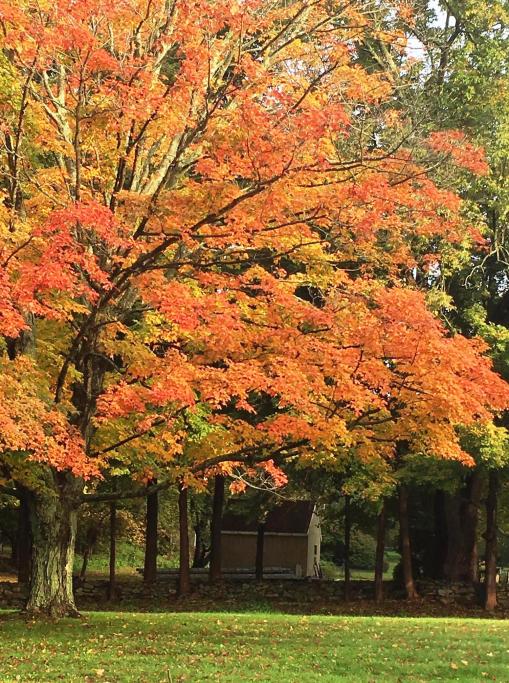
Fall has settled in finally, bringing its colors and cool weather. Some foliage colors were mediocre this year, always to due to the weather. It stayed hot for a long time and we did not get the cool night temperatures which help to trigger the trees to slow down and get ready for dormancy with the side effect of changing leaf color. Still there were some nice sights around the state. Japanese maple ‘Full Moon’ is a reliably consistent beauty sporting bright red leaves for a week or more before dropping its foliage.
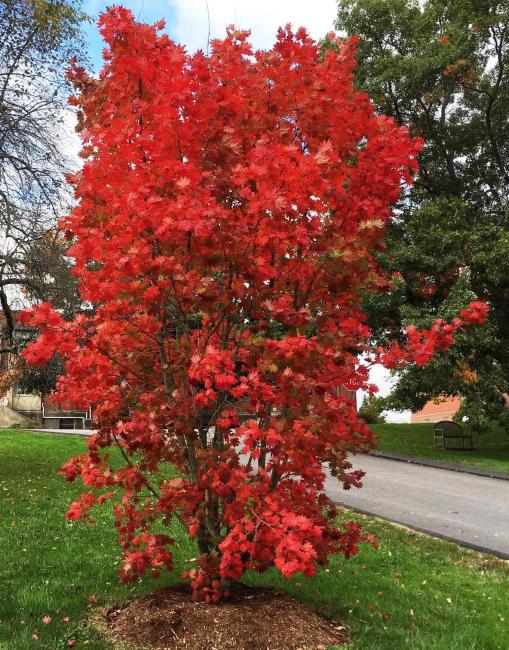
Full Moon Japanese Maple
Evergreen trees also drop foliage, but not all needles at once. The newer green needles will remain on the branches for several years. Eastern white pines will shed their oldest, inner most bundles of needles each year by first turning yellow, then brown and drop. Notice the healthy, younger green needles are retained on the growing ends of the branches.
Fall is time of seed and fruit production in the cycle of life of plants. Crabapples are a great source of food for birds and animals throughout the winter. Some trees have very persistent fruit, hanging on throughout the season, ensuring feathered and fur beings a meal. Viburnum species also are in fruit as are winterberries.
Another interesting tree producing seed pods is the Japanese pagoda tree, Styphnolobium japonicum. It also goes by its other common name Chinese scholar tree due to it commonly being planted around Buddhist temples in Japan. It is native to China and Korea. Panicles of scented white flowers are produced in late summer, turning into strings of pop bead looking yellow seed pods in fall. Pods then turn brown staying on the tree though winter. Japanese pagoda tree makes a great, small specimen tree in yards and larger gardens.
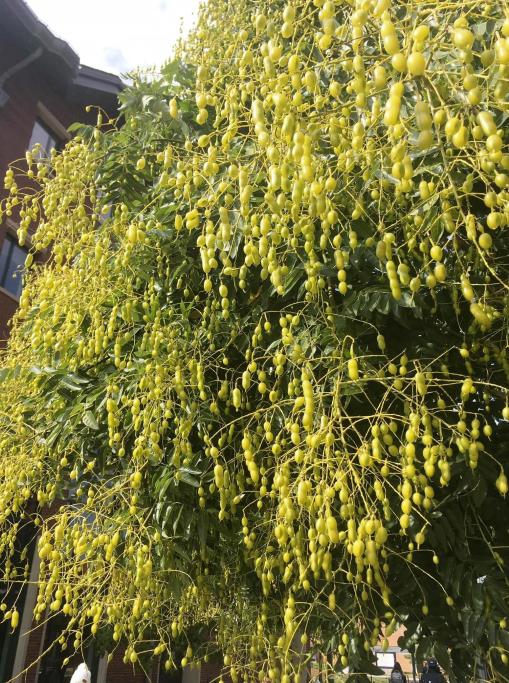
Japanese Pagoda Tree
Fall is a good time to gather dried seeds from annuals and perennials you wish to grow again. Many reseeding annuals drop their seed and seem to pop up as weeds. Collect the seed in paper envelopes or containers to grow them where you want them next year. Cleome, Verbena bonariensis, dill and fennel are just a few that consistently popup all over my gardens. The annual yellow and orange gloriosa daisy evens spread to my adjacent neighbors from the birds eating the seed heads I leave up for them. Some hybrid seeds will not come back the same if you save and plant the seed the following year. Every year I plant blue or blue striped forms of morning glory to climb up the gazebo. They set tons of seeds and drop to the ground to sprout and grow the next year. Unfortunately, they come back a deep purple, not the blue. If I don’t rouge out the volunteers from the new blue flowered plants I put in each year, I will have a mixed show of the blue I newly planted and purple that reseeded themselves. I consider the purple weeds, but others might disagree.
Speaking of weeds, I noticed it was a banner year for Pennsylvania smartweed, Persicaria pensylvanica, formerly called Polygonum pensyvanicum . Smartweed loves it moist and it responded well to all the rain we had this spring and summer, growing like gangbusters and producing a multitude of seed. On the positive side, songbirds love the seed and will be well fed during their time here. Too bad the prolific seed production is going to add to the seed bank in the soil for following years.
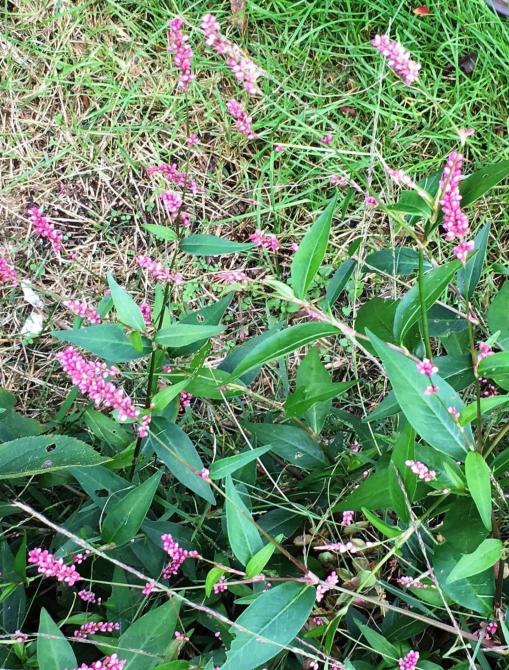
Pennsylvania Smartweed
This year of moisture also lead to much fungal production. Tomatoes were more likely to succumb to early blight and Septoria leaf spot due to leaf wetness aiding disease development and spread. Fungicides applied before fungus hits can protect plants. So will proper spacing of plants and pruning branches to increase airflow and dry leaves. High humidity and lots of moisture ensures mildews, too. Lilacs will develop powdery mildew during mid-summer, but still come back strongly the next year. I just chose to not look at them after August.

Lilac leaves with powdery mildew
Insects are always a part of the garden be it vegetable or perennial. We need the insects for pollination and cycle of all life. The pest ones were not too bad this year as I kept up the removal and scouting for eggs on the squash and squishing caterpillars and worms on the kale, cabbage and Brussels sprouts. Tomato hornworms made a brief appearance, but I caught them in time before much damage was done. Thankfully the cucumber beetles were low in numbers this year and manageable with hand picking them off. I am often fascinated with the beauty and intricacies of insects. I found the delicate dragonfly dead on my breezeway and could not help but marvel at its color and patterns on its body. Dragonflies dart about the yard zigging and zagging at breakneck speed while feeding on the tornado of gnats in the very late afternoon. I call it the dance of the dragonfly and now I see they come dressed in their finery for the occasion.
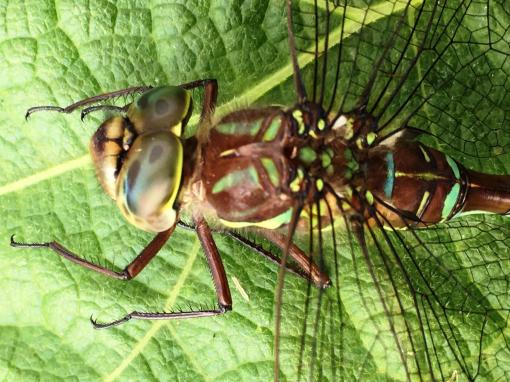
The season wasn’t all work, nor should it be. We made time to enjoy the fruits of our labor and spaces we created, and hope did also. With summer and the main growing season are behind us, I hope it left mark on your heart and memories for your mind, until next year when we can all try again, try some new plant and find a new adventure.
-Carol Quish, all photos copyright C. Quish

October 16, 2018
Posted by uconnladybug under
Butterflies,
Caterpillars,
Environment,
Gardening,
Nature,
Perennials,
Plants,
Pollinators,
Wildflowers | Tags:
asclepias,
Asteroid caterpillar,
asters,
bees honeybee,
brown hooded owlet,
goldenrod,
goldenrod galls,
hairstreak butterfly,
Harkness Park,
insects related to goldenrod,
Native plants,
Praying mantis,
rubber containing plants,
silverrod,
Spotted-joe pye |
Leave a Comment
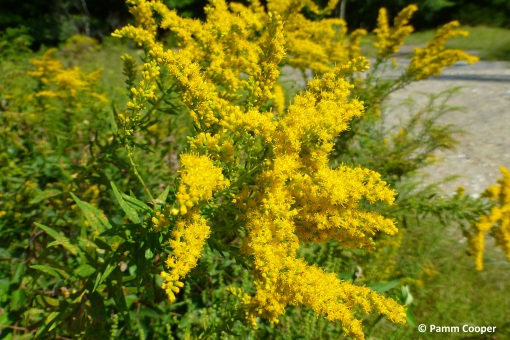
One of many goldenrod species
Goldenrods, Solidago ssp., form one of the most interesting interrelationships between flora and fauna of the late-season flowering plants in New England. The name solidago is from two Latin words meaning ‘to make’ and ‘whole’, referring to its use as herbal remedies in the form of teas or compresses, among other uses. Goldenrods are perennial herbs that are members of the Asteraceae, or aster, family. Flowering from August through September, they are often found blooming together with Joe-Pye weeds and asters. The time of year that they bloom has made them a scapegoat for many allergy sufferers who believe they are to blame them for symptoms that are actually due to ragweed that flower at the same time.
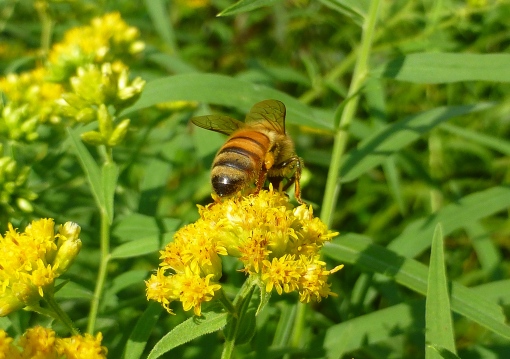
Honey bee on downy goldenrod.
Goldenrods naturally produce rubber, and Thomas Edison actually experimented with the cultivation process to increase the rubber content in the plants. George Washington Carver and Henry Ford devised a process to make a much needed rubber substitute from goldenrod during World War II. It was rather tacky and not as elastic as true rubber, but goldenrods and other native plants such as Asclepias and Chrysothamnus have rubber in sufficient quantity that may one day prove worthwhile. Tall goldenrod (Solidago altissima) had the most rubber content at 6.34 %.
Goldenrods have a unique type of inflorescence that consists of many tiny flowers that aggregate together in a flower head and form a ‘false flower’. The individual flowers are most commonly in the form of ray flowers or disk flowers. Identification of species is often done by observing the hairs on the seeds, which may be visible when the plant is still in flower. Goldenrods vary in height, with the tallest (Solidago altissima) at six feet. Some, such as sweet goldenrod (Solidago odora) have pleasant odors.
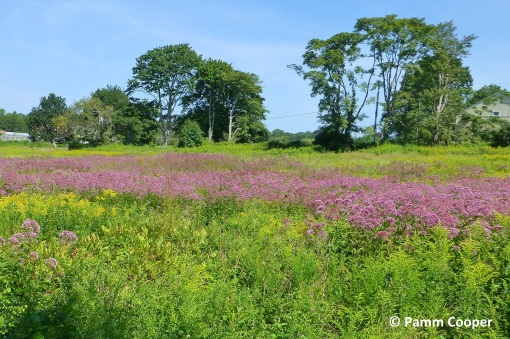
Joe- pye weed and goldenrods blooming together at Harkness Park in Waterford, Connecticut
One of the most common goldenrods in New England is the Canada goldenrod (Solidago canadensis). It is considered alleopathic to sugar maple seedlings, producing chemicals that inhibit their growth. Habitat is disturbed areas like meadows, fields or roadsides. This is a tall plant with hairy stems and a plume flower arrangement.
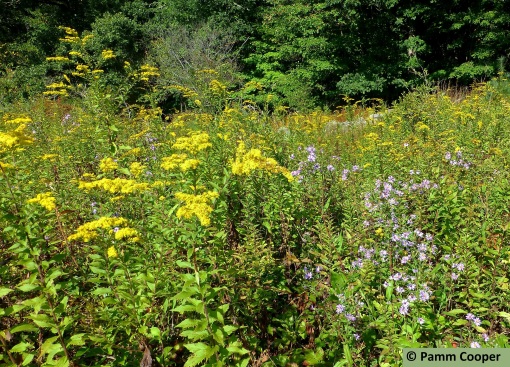
Asters and goldenrods growing together in a waste area
It is associated with the goldenrod gall fly (Eurosta solidaginis) whose larva feed inside a round gall on the stem which is formed by the reaction of the plant to the larva’s saliva. You can easily find these galls when green or later in the season when stalks turn brown. The larva chew an exit hole before the plant tissue hardens up for the winter. In the spring, the adult fly will exit through this hole. Downy woodpeckers and chickadees will peck at these galls to access the larva, especially in harsh winters. Studies have shown the larger the larva inside the gall, the less likely it is to be parasitized by other insects or eaten by birds like downy woodpeckers in the winter. The goldenrod gall moth also causes a stem gall, but this is a spindle- shape rather than a ball. The caterpillar hatches from an egg laid the previous autumn and feeds its way into a stem.
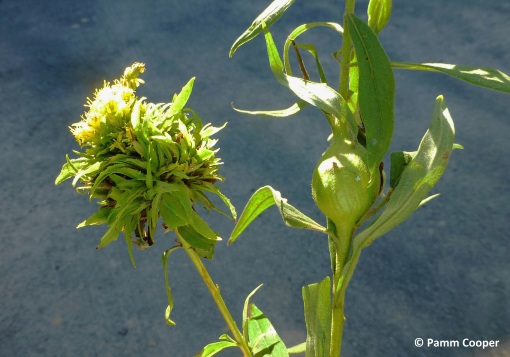
goldenrod bunch gall on left and stem gall on right, caused by the goldenrod gall fly (Eurosta solidaginis)
Licorice goldenrod (Solidago odora) has a licorice or anise scent and the leaves were used in a tea by the Cherokee for colds, coughs, and fevers. This plant is found in the southernmost parts of the New England states, but is absent in Maine. Found in woodlands, along roadsides, disturbed sites and old fields, the flowers have been used to make deep yellow dyes and attract beneficial insects such as lady beetles and lacewings.
White goldenrod (Solidago bicolor) is found at the edges of woodlands. It is also sometimes called ‘silverrod’ in reference to its white flowers. It is the only goldenrod with white flowers in the eastern part of the country. The stamens and pollen will give it a slightly yellow look. Sometimes the spectacular brown hooded owlet caterpillar can be found on this plant where it primarily eats the flower buds and flowers. Found more often on any goldenrods with longer flower spikes, this caterpillar is a favorite of many lepidopterists.
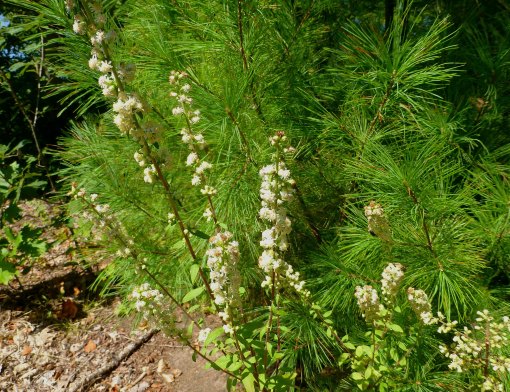
Silverrod at the edge of the woods.
Early goldenrod (Solidago juncea) gets its common name from its bloom time, which can be as much as a month prior to many other goldenrod species. This attractive, slender plant has a very delicate appearance and can be distinguished from other goldenrods by the lack of, or near lack of hairs on the stems and leaves. White-tailed deer, woodchucks, cottontail rabbits and livestock may feed on the plant if less desirable food is available.
Goldenrods provide a source of seeds for eastern goldfinch, tree, swamp and song sparrows as well as some migrating warblers such as the yellow- rumped warblers. Mice and other rodents eat the seeds throughout the winter and have a better time of it when seed heads are pressed down against the ground by heavy snows.
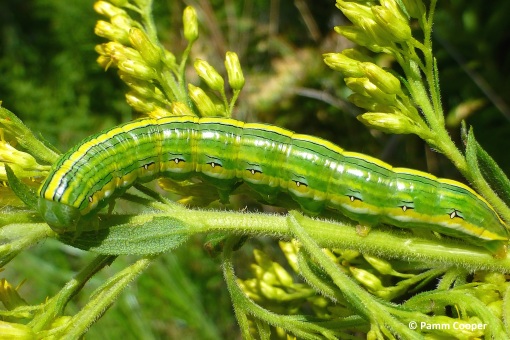
The asteroid caterpillar
Any insects still around in late summer that have an interest in flowers may be found on goldenrods, especially pollen and nectar seekers and their predators. Some of the many insects and other arthropods that rely on goldenrods for survival are bees, wasps, butterflies, moths, flies, beetles, grasshoppers and spiders. Many of these visit for the pollen and nectar often in shorter supply as the season winds down. Migratory butterflies, especially along their shoreline routes, depend upon goldenrods for food sources as they travel south for the winter. Bloom periods are extended for at least two months as different species of goldenrods bloom in succession or coincide with each other.
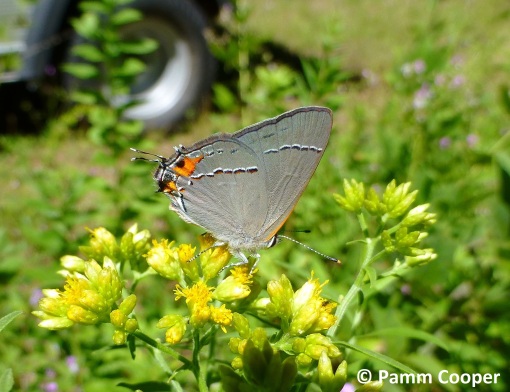
Gray hairstreak butterfly
Black and margined blister beetles are often found on these plants in the late summer and early fall. Many beneficial insects, such as soldier beetles and assassin bugs use the flowers as either food sources or hideouts where they wait to ambush other insects. If you see a butterfly hanging upside down without moving, check and see if an ambush bug or crab spider is feeding on it. Caterpillars such as the asteroid and flower moth caterpillars, aphids, tarnished plant bugs, and many other insects feed on flowers, stems and leaves. Wasps, goldenrod and crab spiders, praying mantids, lacewings, ambush bugs, assassin bugs, spined soldier bugs and birds prey on insects that visit or live on the plants. Cucumber beetles also feed on goldenrod pollen. Some flies cause galls on stems and upper foliage as their larvae feed.
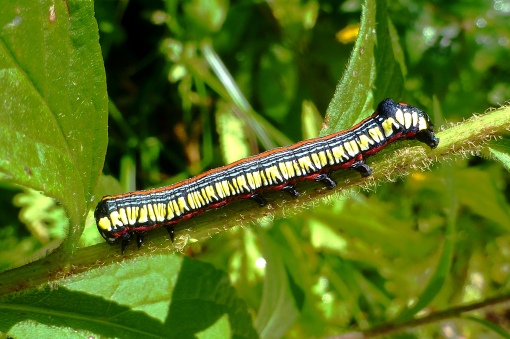
brown hooded owlet caterpillar on goldenrod
Chinese mantids also hang out around goldenrods, and often lay their egg masses on its stems. Look for these in the winter if heavy snows have not mashed the plants into the ground. I sometimes take a stem with the mantid egg case and stick it in my garden. The mantids usually emerge by mid- May, and they disperse quickly
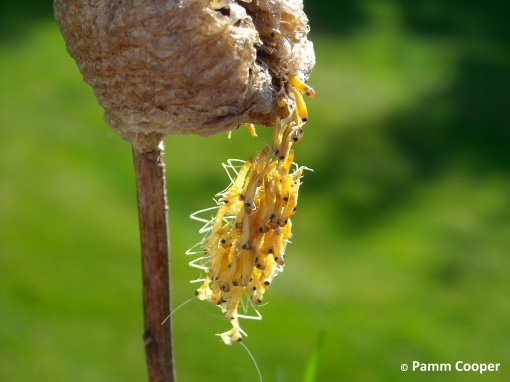
Mantid egg cases are often found on goldenrods where the adult females were hunting the year before. These are mantids just hatching
.
There is a great interconnection between goldenrods and vertebrates and invertebrates, and nature reveals such things to the careful observer. If you happen upon some goldenrod, or seek it out on purpose, just a few moments of careful observation will be rewarded with a peek into the drama that is on display in a simple stand of yellow flowers.
By Pamm Cooper, UConn Home & Garden Education Center
October 11, 2018
Posted by uconnladybug under
Garden Related Activities,
Gardening,
Native shrubs,
Nature,
Perennials,
Wildflowers
Comments Off on The Flora of Bermuda
 Although a month ago the weather in Connecticut was still very summer-like we headed to another sunny location, Bermuda. Bermuda is one of our favorite places to visit as it relatively close by compared to other island destinations. It is a two-hour flight but our preferred mode of transportation is to cruise there. The Bermuda archipelago has a great variety of native, endemic, and invasive flora species. Since the 1500s many plants have been introduced to Bermuda, some to much detriment. In my next blog posting I will discuss the species that are of concern for the island but for now I will share many of the beautiful plants that can be seen there.
Although a month ago the weather in Connecticut was still very summer-like we headed to another sunny location, Bermuda. Bermuda is one of our favorite places to visit as it relatively close by compared to other island destinations. It is a two-hour flight but our preferred mode of transportation is to cruise there. The Bermuda archipelago has a great variety of native, endemic, and invasive flora species. Since the 1500s many plants have been introduced to Bermuda, some to much detriment. In my next blog posting I will discuss the species that are of concern for the island but for now I will share many of the beautiful plants that can be seen there.
Our first foray after docking at King’s Wharf at the Royal Naval Dockyard was the Bermuda Botanical Gardens. Located in Paget Parish about a mile outside of Hamilton, it was established in 1898 as a public garden. In 1921 it became the Agricultural Experiment Station and then, in 1958, due to an increase in tourism and ornamental horticulture it became the Bermuda Botanical Garden.
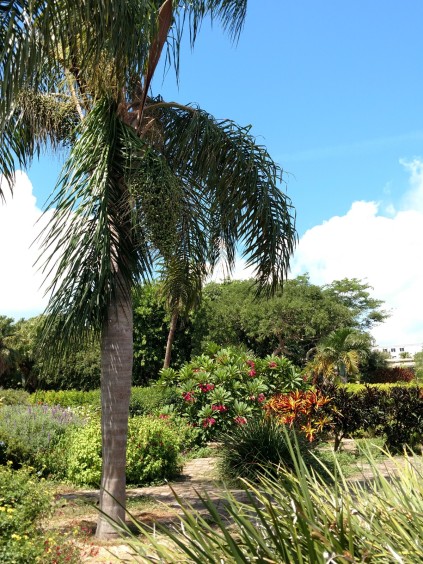
Open year-round (no snow days in Bermuda!), this park has something for every visitor. There are areas devoted to roses, daylilies, hibiscus, conifers, palm trees, sub-tropical fruits, cacti, orchids, an aviary and more. There is even an aromatic sensory garden designed for the visually impaired although it may be enjoyed by anyone. The first tree that caught our attention upon entering the garden was this large banyan, Ficus benghalensis. A member of the fig species, it is epiphytic, beginning its life by germinating in the crack or crevice of a host tree. Also called the strangler fig, it then sends aerial prop roots down to the ground which envelop its host to the point of the death.
Walking a bit further into the gardens we found a section that is devoted to many hybrids of hibiscus that were originally brought to Bermuda from China. Hibiscus is an introduced species which has naturalized, meaning that it will reproduce on its own but does not become invasive.
The four-section formal garden has a 17th-century English Parterre garden, a Persian garden, a Tudor-style children’s garden, and a serene Japanese Zen garden bordered by vibrant pink plumeria hedges.
One of my favorites sections of the botanical garden was a cool and shady area that contained primordial vegetation called Cycads. Among these plants that superficially resemble palms were the large leaved Philodendron shrub, Philodendron bipinnatifidum, and an Abyssinian banana, Ensete ventricosum, that easily dwarfed me. Not really difficult to do, I know, but this plant was easily 10’ tall.
The subtropical fruit garden contained the familiar in the form of bananas, avocado, and citrus and the unfamiliar in the form of papaya trees, whose growth habit reminded me of Brussels sprouts!
So many beautiful plants were not contained to specific areas but were spread around the 35 acres just waiting to be discovered. There were chenille plants, Acalypha hispida, with its soft hanging cat-tail looking panicles. Pink and yellow shrimp plants, Justicia brandegeeana, are evergreen shrubs that are highly attractive to hummingbirds. Another evergreen shrub, Sanchezia speciosa has tubular yellow flowers that extend out of reddish bracts. And of course, what subtropical garden would be complete without bird-of-paradise, Strelitzia reginae?
Day 2 found us at the far east side of Bermuda on the island of St. George’s, one of the larger of 181 islands that make up the Bermuda archipelago. St. George’s has a great public garden, Somers Garden, named for Admiral Sir George Somers, the founder of Bermuda. A fountain sits in the middle of this lovely space, picturesque turquoise stairs lead in from one side and there is also a quintessential moongate, a symbol of good luck.
The trees in this garden are all labeled with their common names and species, always a benefit to visitors. Royal palms, Roystonea regina, line the walkways, there are Indian rubber trees, Ficus elastica, and a Bermuda palmetto, Sabal bermudiana, grew in front of a very large Norfolk Island pine, Araucaria excelsa.
There were also a large variety of flowering plants. Lantana, Lantana camera, an annual familiar to many of us, grew to heights not often seen in Connecticut. The lantana flowers were yellow, white, purple, and variegated. The white and purple-flowered plants are weeping lantana, Lantana montevidensis.
There were more sanchezia, sunny Mexican flame flowers, Senecio confusus, and the deep red-orange flowers of West Indian Jasmine, Ixora.
And a large selection of croton, Codiaeum variegatum, also in sizes way beyond our container houseplants.
Our third day in dock was spent at the Royal Naval dockyard. Built by thousands of convicts in the early 19th century as an anchorage for the British Royal fleet, it remained an active part of the British naval force until 1951. In 1982 it became a National Museum and is open to the public.
The flora that is found here is of a less formal nature than the Botanical and Somers gardens. Plants grow where they like, perhaps a better representation of Bermuda’s nature. Among them is prickly pear, Opuntia sp., a mounding coastal cactus native to Bermuda that is very effective as a defensive planting around fortifications, aloe vera, and dwarf palmetto, Sabal minor.
Tropical milkweed, Asclepias curassavica, is grown as an annual in Connecticut as it does not survive our winters but it thrives in Bermuda. This specimen was inundated with yellow milkweed aphids, a sight that is not uncommon to Connecticut gardeners.
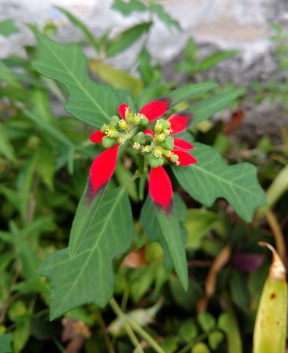
Anyone that has had a poinsettia in their home during the holidays will appreciate this next plant, the Mexican fire plant, Euphorbia heterophylla. Also known as wild poinsettia, this hardy native plant has bluish-green bracts with splashes of bright orange-red at the bases. Although small, it caught my attention as I walked by.
White Egyptian star flowers, Penta sp., rose periwinkles, Catharanthus roseus, deep pink oleander, Nerium oleander, and spider lilies, Hymenocallis sp. were all to be freely found.
So many of these species were introduced either intentionally or unintentionally by humans, animals, or weather-related events. In November I will write about the continued effects of these introductions to the islands of Bermuda.
Susan Pelton, all images by S. Pelton, UConn Home & Garden Education Center
October 5, 2018
Posted by uconnladybug under
Gardening | Tags:
Limestone,
soil pH,
Soil pH testing,
soil testing |
Comments Off on Soil pH – The Master Variable
The UConn Soil Nutrient Analysis Lab tests for and analyzes multiple soil parameters; but none as critical, and as often overlooked, as pH. Soil pH plays a crucial role in the growth of vegetation planted, as well as ground water quality. Before we start talking about soil pH, I think it is a good idea to try to define what exactly pH is, and how it is determined.
When most of us think of pH, a pool probably comes to mind. I remember growing up, watching my mother apply different chemicals to our pool, and impatiently wondering why I had to wait to go swimming. She would tell me that she was adjusting the pH of the water to ensure it was safe to swim in. The basic understanding is that pH is tells us how acidic, neutral, or alkaline something is. To get a little more technical, pH is the measurement of the activity of Hydrogen Ions (H+) in an aqueous solution. The equation for determining and quantifying pH is:
pH = -log10 (aH+)
(aH+ = Hydrogen Ion Activity in Moles/L)
We express pH on a logarithmic scale of 0-14, where 0-6 is considered “acidic”, 7 is “neutral”, and 8-14 is “basic”.
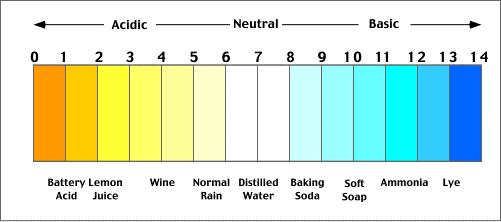
(Image from: http://www.edu.pe.ca/gulfshore/Archives/ACIDSBAS/scipage.htm)
Mineral soil pH values generally range from 3.0 – 10.0. There are numerous factors that determine soil pH including climate, parent material, weathering, relief, and time. Texture and organic matter content also influence soil pH. Most Connecticut soils are naturally acidic. Nutrient availability is directly influenced by pH with most plants (with some exceptions) thriving at pH values between 6 and 7. A majority of nutrients are available within this range.
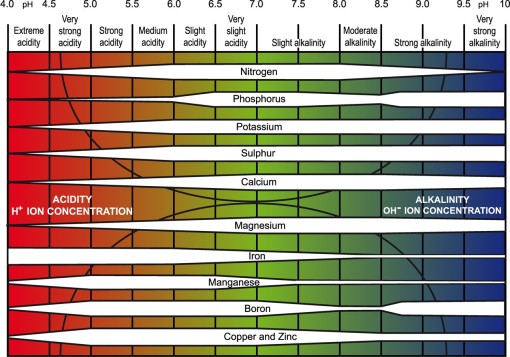
(Image from: http://www.pda.org.uk/pda_leaflets/24-soil-analysis-key-to-nutrient-management-planning/)
Our lab measures pH using an 1:1 soil-to-DI water ratio. The saturated soil paste is mixed, then is analyzed using a glass electrode and a pH meter. We calibrate our meter using 2 solutions with known pH values, 4 and 7. We use these values because we expect most Connecticut soils to fall within this range. Once the initial pH value is obtained, a buffering agent is added. In our lab we use the Modified Mehlich Buffer. A second pH reading is obtained, and from these two values plus crop information, we are able to make limestone and/or sulfur recommendations.
The Buffering Capacity of a soil is the resistance it has to change in pH. Soil buffering is controlled by its Cation-Exchange-Capacity, Aluminum content (in acidic soils), organic matter content, and texture. A soil with a lot of organic matter and clay will have a higher buffering capacity than one with little organic matter that is mostly sandy.
If the soil pH is lower than the target range for a particular plant, limestone would be recommended. Whether you use pelletized, ground or granular limestone, the application rate would be the same. Once the target pH is reached, a maintenance application of 50 lbs/1000 sq ft would be applied every other year to maintain it.
If the soil pH is higher than desired, sulfur recommendations are made. Typically only powdered sulfur is available locally but granular sulfur could be mail ordered. Aluminum sulfate can be substituted for sulfur and used at a higher rate. Check out this list of preferred pH ranges for many common plants.
Monitoring your soil pH is essential to ensure that it is falling within the range best suited for the vegetation you are growing. The Standard Nutrient Analysis performed at our lab gives you a pH value, a buffer pH value, a lime/sulfur recommendation, available micro & macro nutrient levels, and a fertilizer recommendation. For more information on pH, you can contact Dawn or myself (Joe) at the UConn Soil Nutrient Analysis Lab (www.soiltest.uconn.edu)!
Test, don’t guess!
Joe C.











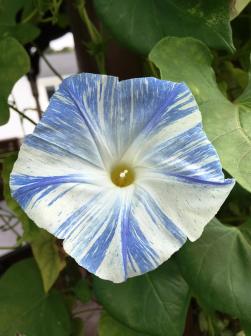











 Although a month ago the weather in Connecticut was still very summer-like we headed to another sunny location, Bermuda. Bermuda is one of our favorite places to visit as it relatively close by compared to other island destinations. It is a two-hour flight but our preferred mode of transportation is to cruise there. The Bermuda archipelago has a great variety of native, endemic, and invasive flora species. Since the 1500s many plants have been introduced to Bermuda, some to much detriment. In my next blog posting I will discuss the species that are of concern for the island but for now I will share many of the beautiful plants that can be seen there.
Although a month ago the weather in Connecticut was still very summer-like we headed to another sunny location, Bermuda. Bermuda is one of our favorite places to visit as it relatively close by compared to other island destinations. It is a two-hour flight but our preferred mode of transportation is to cruise there. The Bermuda archipelago has a great variety of native, endemic, and invasive flora species. Since the 1500s many plants have been introduced to Bermuda, some to much detriment. In my next blog posting I will discuss the species that are of concern for the island but for now I will share many of the beautiful plants that can be seen there.























































